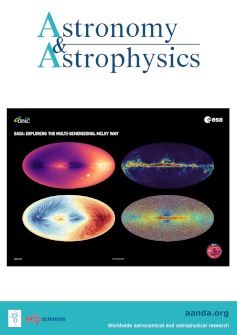Mapping Hα excess candidate point sources in the southern hemisphere using S-PLUS data
IF 5.4
2区 物理与天体物理
Q1 ASTRONOMY & ASTROPHYSICS
引用次数: 0
Abstract
Context. We use the Southern Photometric Local Universe Survey (S-PLUS) Fourth Data Release (DR4) to identify and classify Hα excess point source candidates in the southern sky. This approach combines photometric data from 12 S-PLUS filters with machine learning techniques to improve source classification and advance our understanding of Hα-related phenomena.Aims. Our goal is to enhance the classification of Hα excess point sources by distinguishing between Galactic and extragalactic objects, particularly those with redshifted emission lines, and to identify sources where the Hα excess is associated with variability phenomena, such as short-period RR Lyrae stars.Methods. We selected Hα excess candidates using the (r − J0660) versus (r − i) colour–colour diagram from the S-PLUS main survey (MS) and Galactic Disk Survey (GDS). For the MS sample, dimensionality reduction was achieved using UMAP, followed by HDBSCAN clustering. We refined this by incorporating infrared data, which improved the separation of source types. A random forest model was then trained on the clustering results to identify key colour features for the classification of Hα excess sources. New effective colour–colour diagrams were constructed by combining data from S-PLUS MS and infrared data. These diagrams, alongside tentative colour criteria, offer a preliminary classification of Hα excess sources without the need for complex algorithms.Results. Combining multi-wavelength photometric data with machine learning techniques significantly improved the classification of Hα excess sources. We identified 6956 sources with an excess in the J0660 filter, and cross-matching with SIMBAD allowed us to explore the types of objects present in our catalogue, including emission-line stars, young stellar objects, nebulae, stellar binaries, cataclysmic variables, variable stars, and extragalactic sources such as Quasi-Stellar Objects (QSOs), Active Galactic Nuclei (AGN), and galaxies. The cross-match also revealed X-ray sources, transients, and other peculiar objects. Using S-PLUS colours and machine learning, we successfully separated RR Lyrae stars from other Galactic stars and from extragalactic objects. Additionally, we achieved a clear separation between Galactic and extragalactic sources. However, distinguishing cataclysmic variables from QSOs at specific redshifts remained challenging. Incorporating infrared data refined the classification, enabling us to separate Galactic from extragalactic sources and to distinguish cataclysmic variables from QSOs. The Random Forest model, trained on HDBSCAN results, highlighted key colour features that distinguish the different classes of Hα excess sources, providing a robust framework for future studies, such as follow-up spectroscopy.求助全文
约1分钟内获得全文
求助全文
来源期刊

Astronomy & Astrophysics
地学天文-天文与天体物理
CiteScore
10.20
自引率
27.70%
发文量
2105
审稿时长
1-2 weeks
期刊介绍:
Astronomy & Astrophysics is an international Journal that publishes papers on all aspects of astronomy and astrophysics (theoretical, observational, and instrumental) independently of the techniques used to obtain the results.
 求助内容:
求助内容: 应助结果提醒方式:
应助结果提醒方式:


